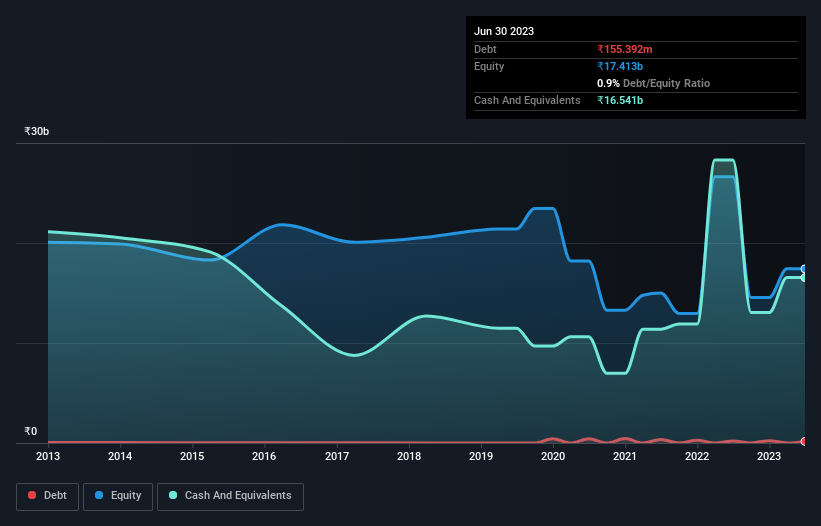Is GlaxoSmithKline Pharmaceuticals (NSE:GLAXO) Using Too Much Debt?

Legendary fund manager Li Lu (who Charlie Munger backed) once said, 'The biggest investment risk is not the volatility of prices, but whether you will suffer a permanent loss of capital.' It's only natural to consider a company's balance sheet when you examine how risky it is, since debt is often involved when a business collapses. Importantly, GlaxoSmithKline Pharmaceuticals Limited (NSE:GLAXO) does carry debt. But is this debt a concern to shareholders?
When Is Debt Dangerous?
Generally speaking, debt only becomes a real problem when a company can't easily pay it off, either by raising capital or with its own cash flow. Part and parcel of capitalism is the process of 'creative destruction' where failed businesses are mercilessly liquidated by their bankers. However, a more frequent (but still costly) occurrence is where a company must issue shares at bargain-basement prices, permanently diluting shareholders, just to shore up its balance sheet. Of course, the upside of debt is that it often represents cheap capital, especially when it replaces dilution in a company with the ability to reinvest at high rates of return. When we think about a company's use of debt, we first look at cash and debt together.
See our latest analysis for GlaxoSmithKline Pharmaceuticals
How Much Debt Does GlaxoSmithKline Pharmaceuticals Carry?
As you can see below, GlaxoSmithKline Pharmaceuticals had ₹155.4m of debt at March 2023, down from ₹200.8m a year prior. However, it does have ₹16.5b in cash offsetting this, leading to net cash of ₹16.4b.

How Healthy Is GlaxoSmithKline Pharmaceuticals' Balance Sheet?
We can see from the most recent balance sheet that GlaxoSmithKline Pharmaceuticals had liabilities of ₹13.3b falling due within a year, and liabilities of ₹2.59b due beyond that. Offsetting this, it had ₹16.5b in cash and ₹3.30b in receivables that were due within 12 months. So it can boast ₹3.99b more liquid assets than total liabilities.
This state of affairs indicates that GlaxoSmithKline Pharmaceuticals' balance sheet looks quite solid, as its total liabilities are just about equal to its liquid assets. So while it's hard to imagine that the ₹247.4b company is struggling for cash, we still think it's worth monitoring its balance sheet. Succinctly put, GlaxoSmithKline Pharmaceuticals boasts net cash, so it's fair to say it does not have a heavy debt load!
Fortunately, GlaxoSmithKline Pharmaceuticals grew its EBIT by 3.6% in the last year, making that debt load look even more manageable. There's no doubt that we learn most about debt from the balance sheet. But it is future earnings, more than anything, that will determine GlaxoSmithKline Pharmaceuticals's ability to maintain a healthy balance sheet going forward. So if you're focused on the future you can check out this free report showing analyst profit forecasts.
Finally, while the tax-man may adore accounting profits, lenders only accept cold hard cash. GlaxoSmithKline Pharmaceuticals may have net cash on the balance sheet, but it is still interesting to look at how well the business converts its earnings before interest and tax (EBIT) to free cash flow, because that will influence both its need for, and its capacity to manage debt. Over the most recent three years, GlaxoSmithKline Pharmaceuticals recorded free cash flow worth 79% of its EBIT, which is around normal, given free cash flow excludes interest and tax. This free cash flow puts the company in a good position to pay down debt, when appropriate.
Summing Up
While we empathize with investors who find debt concerning, you should keep in mind that GlaxoSmithKline Pharmaceuticals has net cash of ₹16.4b, as well as more liquid assets than liabilities. The cherry on top was that in converted 79% of that EBIT to free cash flow, bringing in ₹4.4b. So we don't think GlaxoSmithKline Pharmaceuticals's use of debt is risky. When analysing debt levels, the balance sheet is the obvious place to start. However, not all investment risk resides within the balance sheet - far from it. For example, we've discovered 1 warning sign for GlaxoSmithKline Pharmaceuticals that you should be aware of before investing here.
When all is said and done, sometimes its easier to focus on companies that don't even need debt. Readers can access a list of growth stocks with zero net debt 100% free, right now.
If you're looking to trade GlaxoSmithKline Pharmaceuticals, open an account with the lowest-cost platform trusted by professionals, Interactive Brokers.
With clients in over 200 countries and territories, and access to 160 markets, IBKR lets you trade stocks, options, futures, forex, bonds and funds from a single integrated account.
Enjoy no hidden fees, no account minimums, and FX conversion rates as low as 0.03%, far better than what most brokers offer.
Sponsored ContentNew: Manage All Your Stock Portfolios in One Place
We've created the ultimate portfolio companion for stock investors, and it's free.
• Connect an unlimited number of Portfolios and see your total in one currency
• Be alerted to new Warning Signs or Risks via email or mobile
• Track the Fair Value of your stocks
Have feedback on this article? Concerned about the content? Get in touch with us directly. Alternatively, email editorial-team (at) simplywallst.com.
This article by Simply Wall St is general in nature. We provide commentary based on historical data and analyst forecasts only using an unbiased methodology and our articles are not intended to be financial advice. It does not constitute a recommendation to buy or sell any stock, and does not take account of your objectives, or your financial situation. We aim to bring you long-term focused analysis driven by fundamental data. Note that our analysis may not factor in the latest price-sensitive company announcements or qualitative material. Simply Wall St has no position in any stocks mentioned.
About NSEI:GLAXO
GlaxoSmithKline Pharmaceuticals
Manufactures, distributes, and trades in pharmaceuticals in India and internationally.
Outstanding track record with flawless balance sheet.


